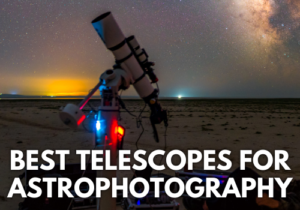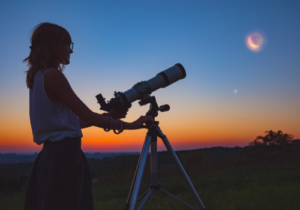9 Best Telescope Filters; Reviews
Disclosure: This post contains affiliate links and I may earn a small commission (at no extra cost to you) if you click through and make a purchase. Thanks in advance – I really appreciate it!
There is a best telescope filter for every application in astronomy, whether you want to enhance views through the eyepiece for observations of the moon and the planets or wish to bring out details during astrophotography.
The filters we use for visual astronomy reduce the amount of light that comes through the eyepiece. Filters never increase the amount of light. By reducing the level of light in one part of the light spectrum, the filter may help to bring out another part of the spectrum, which will show us details we might not have otherwise noticed.
Here is a review of the 9 best telescope filters that you should definitely look at if you’re serious about astronomy.
Best Telescope Filters
Comparison Table
| Image | Title | Price | Buy |
|---|---|---|---|
 | Orion 05662 1.25-Inch 13 Percent Transmission Moon Filter | See on Amazon | |
 | Gosky 1.25 Inch Light Pollution Filter | See on Amazon | |
 | Orion 5657 2-Inch UltraBlock Narrowband Eyepiece Filter | See on Amazon | |
 | Orion 05514 Basic Set of 1.25-Inch Four Color Filters | See on Amazon | |
 | Orion 5660 1.25-Inch SkyGlow Broadband Eyepiece Filter | See on Amazon | |
 | Neewer 1.25 inches Telescope Moon Filter, CPL Filter, 5 Color Filters Set(Red, Orange, Yellow, Green, Blue) | See on Amazon | |
 | Orion 05598 1.25-Inch 25 Percent Transmission Moon Filter | See on Amazon | |
 | Celestron 94107 Variable Polarizing Filter 1.25" | See on Amazon | |
 | Celestron 94243 6" Telescope Filter, | See on Amazon |
Product prices and availability are accurate as of the date/time indicated and are subject to change. Any price and availability information displayed on [relevant Amazon Site(s), as applicable] at the time of purchase will apply to the purchase of this product.
Prices pulled from the Amazon Product Advertising API on:Best Telescope Filters - Reviews
1. Orion 05662 1.25-Inch 13 Percent Transmission Moon Filter
- The Orion 1.25 inch 13 percent Transmission Moon Filter reduces glare so you can see more lunar detail and surface features with your telescope
- Metal filter cell threads directly into the 1.25 inch barrel of your telescope eyepiece
- Especially useful for large aperture telescopes through which the light of the Moon can be extremely overwhelming
- Telescope eyepiece filter transmits only 13 percent of the incoming light, boosting contrast and ability to discern detail on the Moon
- Perfectly neutral color will not alter the natural color of the Moon
Prices pulled from the Amazon Product Advertising API on:
Product prices and availability are accurate as of the date/time indicated and are subject to change. Any price and availability information displayed on [relevant Amazon Site(s), as applicable] at the time of purchase will apply to the purchase of this product.
The Orion 05662 is one of the best telescope filters because it helps considerably in decreasing the moon glare and improving contrast so that moon’s craters and valleys can be seen in greater detail.
It improves the image quality by fitting directly to the 1.25-inch eyepiece of the telescope. It helps in blocking out almost 87 percent of light gathered by the telescope, providing a clearer view with higher contrast on the edges.
Due to this higher contrast provided by the 1.25 inch 13 percent transmission moon filter, the astronomer is able to do a detailed study of the moon. This Orion Moon filter is special because it does not alter the color while reducing overall brightness.
Irradiation is the drop in image quality at the boundary between light and dark areas, this eyepiece filter helps in reducing irradiation as well.
The Orion neutral density eyepiece filter also helps in conserving dark-adapted vision while viewing the moon.
2. Gosky 1.25-Inch Light Pollution Filter for Telescope
- Improve the visibility of deep sky objects by blocking out the mercury vapor, sodium vapor, and other such emission lines from man-made or natural sources which contribute to light pollution
- Improves contrast on reddish planetary detail. Works well in telescopes of all apertures
- The filter will fit all standard sized 1.25 eyepieces and accessories. Can be threaded on both sides for stacking with other filters if necessary
- Comes with sturdy plastic case-proect the eyepiece from dust and moisture
- Mounted in a nicely anodized housing.
Prices pulled from the Amazon Product Advertising API on:
Product prices and availability are accurate as of the date/time indicated and are subject to change. Any price and availability information displayed on [relevant Amazon Site(s), as applicable] at the time of purchase will apply to the purchase of this product.
The Gosky 1.25-inch is one of the best telescope filters for removing light pollution to enhance viewing of the moon and other celestial bodies. This is the filter that I will highly recommend for viewing the night sky if you live in a light-polluted area of a city.
Most people think that filters are unnecessary and a mere add-on cost for your astronomy adventure. Definitely, it is an add-on cost but a worthy investment if you want to get a cleaner crisp view and better contrast of celestial bodies.
When viewing through the eyepiece without the filter, typically what you would see is a flood of light coming from a round object. However, with a filter like this one, you would enjoy the details of the craters and the rough surface of the moon.
Moreover, this filter sharply improves looking for more dim objects by blocking most of the unwanted city glow.
3. Orion 5657 2-Inch UltraBlock Narrowband Filter
- The Orion UltraBlock is the ideal eyepiece filter for deep-sky observers located at highly light-polluted sites
- Narrowband filter blocks all forms of light pollution
- Enhances the presence of a significant number of fainter deep-sky objects
- Compatible with threaded Orion 2 eyepieces. Metal filter cell construction.
- Save yourself a trip to dark skies - with the UltraBlock filter you can enjoy the stars from the subur
Prices pulled from the Amazon Product Advertising API on:
Product prices and availability are accurate as of the date/time indicated and are subject to change. Any price and availability information displayed on [relevant Amazon Site(s), as applicable] at the time of purchase will apply to the purchase of this product.
The largest challenges to viewing deep-sky objects are light pollution and atmospheric refraction.
These both easily drown out distant targets. For this reason, Orion’s UltraBlock NarrowBand filter can be a boon to your astronomy.
The UltraBlock NarrowBand filter helps remove light pollution because it only allows light with the frequency of H-Beta and OIII to pass through. As a result, you’ll see increased contrast in your telescope image.
Many nebulae shine in these wavelengths, so only letting these frequencies of the light pass to your eye means you should see nebulae much more easily.
This is a 2″ filter and is, in our view, the best ‘all round’ filter.
If you can only afford one telescope filter, then this one is ideal. It will give you better contrast with a light pollution filter and cost less than individual OIII and H-Beta filters.
4. Orion 05514 1.25-Inch Four Color Filters
- Handy color planetary telescope eyepiece filters help enhance your view of the planets and Moon, unveiling specific features and enabling you to discern more detail
- High-grade Schott optical glass is vat-dyed for even color coating, then anti-reflection coated for maximum light throughput
- Anodized aluminum cells are double-threaded to permit filter stacking for multiple filter use
- Includes 15 Deep Yellow, 25 Red, 58 Green and 80A Medium Blue
- Each filter has a metal filter cell and is threaded for use with Orion 1.25 inch telescope eyepieces and filter-threaded accessor
Prices pulled from the Amazon Product Advertising API on:
Product prices and availability are accurate as of the date/time indicated and are subject to change. Any price and availability information displayed on [relevant Amazon Site(s), as applicable] at the time of purchase will apply to the purchase of this product.
Planetary and lunar observation is almost always improved by the use of color filters. They bring out subtle details by selectively increasing the contrast among markings of different hues, and by reducing “irradiation,” the smudging of the boundaries between light and dark regions due primarily to turbulence in the Earth’s atmosphere.
The Orion 05514 set of 1.25-inch color planetary telescope eyepiece filters help enhance your view of the planets and Moon, unveiling specific features and enabling you to discern more detail
The filters are made of high-grade Schott optical glass which is vat-dyed for even color coating, then anti-reflection coated for maximum light throughput.
Anodized aluminum cells are double-threaded to permit filter stacking for multiple filter use
The whole set includes #15 Deep Yellow, #25 Red, #58 Green, and #80A Medium Blue color filters.
5. Orion 5660 1.25-Inch SkyGlow Broadband Filter
- The SkyGlow filter enhances deep-sky observations in moderately light-polluted skies
- Broadband filter blocks the most common wavelengths of light pollution for increased contrast and better views
- SkyGlow eyepiece filters improve views of nebulas, galaxies as well as open and globular star clusters
- 1.25 filter with metal filter cell construction compatible with all 1.25 Orion telescope eyepieces and filter-threaded 1.25 accessor
Prices pulled from the Amazon Product Advertising API on:
Product prices and availability are accurate as of the date/time indicated and are subject to change. Any price and availability information displayed on [relevant Amazon Site(s), as applicable] at the time of purchase will apply to the purchase of this product.
This 1.25″ SkyGlow Broadband Telescope filter is an advanced multilayer “interference” filter that blocks the most common wavelengths of light pollution while passing desirable wavelengths with very little attenuation, yielding dramatically better deep-sky views.
It features improved blocking of mercury-vapor light and higher transmission at critical hydrogen-alpha and hydrogen-beta lines than competing filters.
Bright, light-polluted skies appear much darker, and the contrast between object and sky is improved significantly.
The Orion 5660 is one of the best telescope filters for viewing deep space objects.
SkyGlow filter allows maximum transmission of the important wavelengths of hydrogen-alpha, hydrogen-beta, and doubly ionized oxygen-the ones most commonly emitted by nebulas. Views of galaxies and star clusters are also enhanced.
6. Neewer 1.25 inches Telescope Filter Set
- Mounting bracket has curved base with two holes and attaches to telescope tube with bolts or screws;bracket will not slide into a dovetail base
- Wth it you are more convenient to find the s
Prices pulled from the Amazon Product Advertising API on:
Product prices and availability are accurate as of the date/time indicated and are subject to change. Any price and availability information displayed on [relevant Amazon Site(s), as applicable] at the time of purchase will apply to the purchase of this product.
This SVBONY finder scope is a secondary scope that’s used to help you locate objects in the main telescope.
It has 3 thumb screws that allow positioning XY adjustment for precise telescope alignment.
It provides 5×24 low power magnification.
The finderscope should be fixed to the body of a more powerful telescope and pointed in the same direction for initially locating an object to be observed
The optical tube has a glossy black metallic finish and a crosshair reticle.
The finderscope comes with mounting brackets and dust caps, and the bracket fits any telescope and the included dust caps protect against dust and fingerprints.
7. Astromania 9x50 Angled Finder Scope
- 9x50 finder scope with 50mm objective lens diameter, brighter DSOs directly visible.
- Makes a large number of aditional stars available - a big plus for being able to successfully locate objects.
- The 90° viewing angle makes your searching much more easy and comfortable, even near the zenith.
- The achromatic optics provide a bright, true-to-life image at 9x magnification. In addition, the optical surfaces have been multi-coated to prevent irritating reflections.
- Finder fits onto most telescopes, easy focusing at the objective lens. Adjustment of finder scope alignment via two screws and spri
Prices pulled from the Amazon Product Advertising API on:
Product prices and availability are accurate as of the date/time indicated and are subject to change. Any price and availability information displayed on [relevant Amazon Site(s), as applicable] at the time of purchase will apply to the purchase of this product.
This finder scope has a 50mm aperture, and so it provides a particularly bright image. Objects which you are not even able to see using just the naked eye will usually become directly visible.
Also, if you are trying to locate one of the brighter DSOs, this will no longer be able to remain hidden, giving itself up to your searching eye.
After you attach this scope to your telescope tube, you can use its low-level magnification to track whatever you’re looking for.
The unit looks like your average straight-through scope. But, it’s equipped with some advanced features.
The first is the red LED light. It illuminated the reticles and is less obtrusive than pure white LED lights. It’s also dimmable, which is a nice touch.
The Astromania finder scope has a wide field of view to make locating objects easier.
With this finderscope, you can enjoy both a comfortable 90° viewing angle and an upright, non-reversed image.
An integrated prism displays objects in a similar way to that with binoculars or spotting scopes.
8. Talcope Brightness Red Dot Finderscope
- Simple to Install: Red dot sighting device aiming your telescope is effective. Adjustment knobs work well, you evened up the finder with the adjustment knobs before you put it on your telescope. It was a breeze dialing it in.
- Quality Assurance: Comes with a one-year after-sales guarante
Prices pulled from the Amazon Product Advertising API on:
Product prices and availability are accurate as of the date/time indicated and are subject to change. Any price and availability information displayed on [relevant Amazon Site(s), as applicable] at the time of purchase will apply to the purchase of this product.
This finderscope red dot sight comes with an adjustable LED dot that is projected onto a non-magnifying viewing window. It’s easy to find the red dot because it contrasts well with the color of the lens material. So you can aim the main telescope quickly and easily.
The star pointer brightness of the red dot is adjustable to different environments. It is bright enough to use during the day or night.
It comes with a bracket that fits the dovetail mounting base of almost all the telescopes.
It also comes with a long-lasting CR2032 3V battery to ensure long stargazing sessions.
The finderscope is beginner-friendly and it’s very easy to set up and use.
9. SVBONY SV182 Finder Scope
- Improve the light gathering capabilities; 30mm wide aperture; has a strong light gathering capability; allowing you to see faint objects in the sky
- Appropriate focal length; 120mm focal length; which is ideal for your observation; a powerful 6x crosshair; reticles make lining up your target easier
- Comfortable to observe; 90-degree right angle; comfortable observation angle improves the experience of using the finder; no need to bend over or twisting your neck; improve the experience of your observation
- Get a erect image; prism steering was added to the finder optical system; meet the observation habit that people always have
- Fully multi coated lens coating; improve the light transmission; provide a clear view of the night sky; ensures a sharp and bright image; making it easy to find your target f
Prices pulled from the Amazon Product Advertising API on:
Product prices and availability are accurate as of the date/time indicated and are subject to change. Any price and availability information displayed on [relevant Amazon Site(s), as applicable] at the time of purchase will apply to the purchase of this product.
The SV182 finder scope with 6x power magnification and a 30mm diameter lens collects ample light to make aiming your telescope easy and fun.
The SV182 finder scope features a fully multi-coated Achromatic 2-Element lens design that enables the finderscope to effectively eliminate chromatic aberrations.
The finderscope is easy to use as it comes with a metal finder bracket, 2 plastic adjustment screws, a 90-degree angle, and a fixed spring push-pull screw.
You will only need to adjust 2 screws to quickly find and hone in on the target.
The inside of the SV182 finder scope’s optical tube is fully threaded to minimize reflections.
This one of the best telescope finderscopes weighs only 0.49lbs. that won’t add excessive weight or bulk to your main telescope.

How to Use a Telescope Finder Scope
Using a telescope finder scope is pretty straightforward. Make sure that you align the finderscope with your telescope during the day.
First of all, pull out the clear plastic sheet that is at the front and on the bottom. This allows the battery to make contact so that the red dot appears when you switch it on.
Next, try the finder by switching it on. Look through the hole at the front of the finder and you should see the red dot or reticle and be able to make it brighter or dimmer by using a switch or a knob on the finderscope.
Now set your scope up as normal but put the red dot finder on instead of the usual optical finder.
Point your telescope to something like a TV aerial or a chimney – anything about that size will do, and the further away the better.
Looking through a low-power eyepiece (25mm is ideal) find the object by adjusting your telescope and focusing the object.
Adjust the mount using the slow-motion controls so that the object is right in the center of the view.
Adjust the finder so that the red dot or reticle is exactly on the object you were looking at.
Switch it off and wait until dark.
You now use it by switching the finder on, then looking through the finder so that the red dot lines up to the target you are going to observe through your telescope.
Once the red dot is exactly over the star or planet it should be exactly in the center of your eyepiece view.
Remember to switch off your finderscope once you have found your target to save the battery.
Types of Telescope Finderscopes
The finderscopes mainly come in three different designs.
1. Red Dot Finder
The Red Dot Finderscopes are simple and easy-to-use and they generally come with zero magnification view of the sky that is right-side up and left-to-right correct.
Some red dot finders project shapes other than a red dot, like a bull’s eye or a crosshair. Other models let you choose from a collection of illuminated reticles or dots.
2. Right Angle Finder
A right-angle finder scope has an eyepiece that faces up. This makes it easier to look through, especially when the telescope is pointing high overhead. Many right-angle finder scopes are “image erect” or “image correct” as well, which means the image you see will be right side up and/or left-to-right correct.
So if you wish to avoid a stiff neck and painful contortions when looking through a straight-through finder, a right-angle finder scope is the solution.
These scopes use a small prism diagonal to direct the light upward into the eyepiece at a right angle to the finder tube.
Right-angle finders can be used with most telescopes, but they tend to be especially easy to use with Newtonian reflectors when they are placed in proximity to the telescope’s focuser.
3. Straight-Through Finderscopes
A straight-through finder puts the eyepiece at the back facing out. These finderscopes look like miniature telescopes. You look straight through the eyepiece and down the optical axis to achieve magnification. Straight-through models are best for refractors or Schmidt-Cassegrain telescopes.
Conclusion
I hope this article has helped you sort out and compare different models to pick out the best telescope finderscope for yourself. These devices work by showing more of the night sky than your telescope does, but they work by centering on exactly the same piece of sky. With the information in this guide, you will be ready to make the right choice for your telescope and observing interests.
Written by:

Prakash Chandra
I am a science and technology enthusiast who is curious about emerging concepts in spaceflight, aerospace, and robotics. My passion for astronomy started in my childhood, and my craze for writing started when my works got published in my school's newspaper.
ABOUT US
We are a team of active amateur astronomers, here to help you with all your astronomy and science related needs – this is anything, from reviewing the latest telescopes to be released to talking about gravity and neurons. The Big Bang Optics was started because of our love for astronomy and to help others like us find the best telescope and accessories.
LEGAL DISCLAIMER
The Big Bang Optics is a participant in the Amazon Services LLC Associates Program, an affiliate advertising program designed to provide a means for sites to earn advertising fees by advertising and linking to Amazon.com. The Big Bang Optics also participates in affiliate programs with Clickbank and other sites. The Big Bang Optics is compensated for referring traffic and business to these companies.













